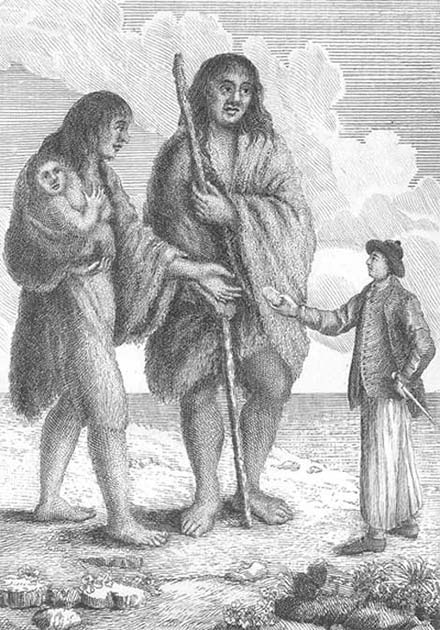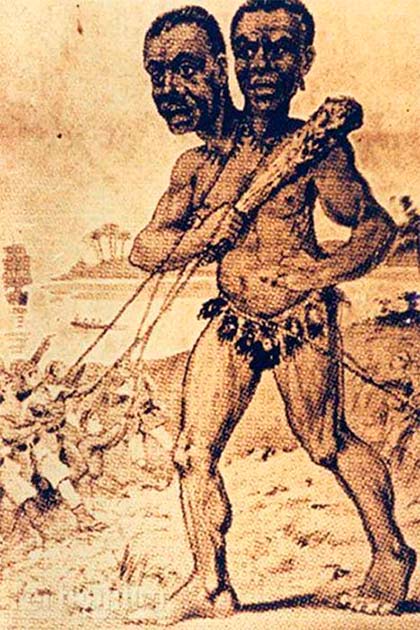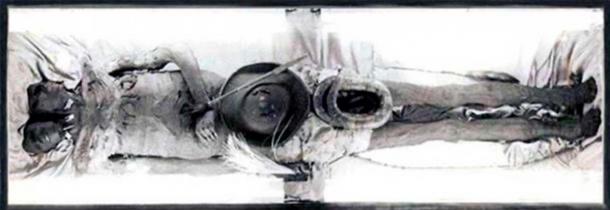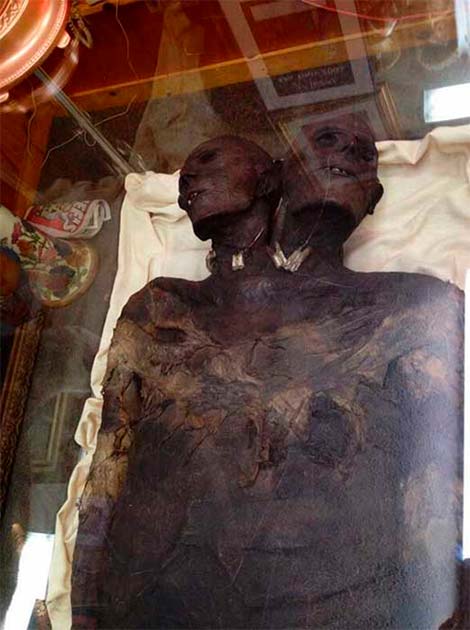The Discovery of a Two-Headed Giant by Skilled Excavators.
In the annals of history, tales of giants have permeated diverse cultures, weaving a rich tapestry of myth and legend. From the towering Greek titans to the colossal Norse beings, the Chinese Pangu or even the biblical Goliath, the allure of these larger-than-life figures has persisted. Amidst this array of tales, one peculiar giant claims attention—the enigmatic Kap Dwa.
Purportedly a Patagonian giant unearthed off the coast of South America, Kap Dwa’s colossal frame is not its sole peculiarity; it boasts an astonishing two heads. The tantalizing question lingers: Could this giant be more than a fantastical tale? While scientific plausibility suggests the potential existence of such a giant being, the shadow of P. T. Barnum’s influence and the absence of expert scrutiny cast a veil of skepticism over Kap Dwa’s authenticity.

English sailor offering bread to a female Patagonian giant from the first Italian edition of John Byron’s ‘A Voyage Round the World in His Majesty’s Ship the Dolphin.’ (London, 1767). (Princeton)
English sailor offering bread to a female Patagonian giant from the first Italian edition of John Byron’s ‘A Voyage Round the World in His Majesty’s Ship the Dolphin.’ (London, 1767). (Princeton)
Giants in Patagonia: The Origin of the Kap Dwa Giant Legend
Kap Dwa is supposedly a 12-foot-tall (3.66 meter) Patagonian giant whose body somehow made it to a museum in Baltimore, Maryland, USA. Patagonia has been considered a land inhabited by giants for a long time. In fact, legends of Patagonian giants have been traced back to a story told by the explorer Ferdinand Magellan.
Lovelock Cave: A Tale of Giants or A Giant Tale of Fiction?
The Shameful History of Human Zoos: Displaying ‘Exotic Foreigners’ Only Stopped 60 Years Ago
During their travels, Magellan and his men stopped on the beaches of South America and went inland to explore. Having landed in Patagonia, it is said that they encountered natives twice the size of a normal man. This is probably because a few of the indigenous peoples of the region, namely the Tehuelche, do happen to be taller than the average European was at the time.
This height difference may have been exaggerated, leading to the long-standing European myth that Patagonia was a land of giants. However, it prompts contemplation—could there be a kernel of truth behind the legends? Is it conceivable that a few real giants once roamed the Patagonian landscapes, with Kap Dwa standing as a potential example of this extraordinary phenomenon?

Drawing representing the giant Kap Dwa. (CC BY SA)
The History (or Legend) of the Kap Dwa
There are two conflicting stories of the origin of the Kap Dwa giant. According to the first, Kap Dwa was encountered by Spanish sailors in around 1673 on the beaches of Patagonia. He was captured and taken onto their ship where they strapped him to the mast.
When he got free of the mast, he skirmished with them and was killed by a pike piercing his chest. Subsequently, in the 19th century, the preserved body found its way to Britain and later the United States. There, it became a focal point of numerous sideshows and freak shows, captivating audiences as a curious spectacle from the uncharted realms of the world.

Publicity to see Kap Dwa. (CC BY SA)
An alternative account of Kap Dwa’s discovery suggests that the Patagonian giant was already dead when found on a beach, having been impaled by a spear through the chest. In this version of events, Paraguay natives stumbled upon the lifeless body and mummified it, incorporating it into their religious practices.
Subsequently, the British schooner captain, George Bickle, heard about this peculiar discovery, infiltrated Paraguay and stole the body. After this bizarre body snatching, he successfully brought it back with him to Britain.
In both versions, the body ends up in the hands of showmen who add it to their collection of curiosities. There remains some disagreement over its authenticity. Some believe it to be genuine, while others are convinced that it to be an elaborate hoax. Let us examine the evidence and see which one sounds more likely.

Full length image of the body of Kap Dwa. (CC BY SA)
Is a Two-Headed 12-Foot Man Even Possible?
Although a real two-headed giant seems far-fetched, on par with discovering a real dragon or a real troll, it is not actually as unlikely as it sounds. Let us first examine the creature’s unusual height.
There have been people of unusual stature due to the condition known as gigantism. The tallest person in recorded history for which there is indisputable evidence is Robert Wadlow (1918-1940) who was 8 feet 11 inches (2.47 meters) tall and still growing when he suddenly died at the age of 22.

Postcard of Robert Wadlow with his father. (Public domain)
Although people have been found who are over 8 feet tall (2.44 meters), no living people or skeletal remains (for which the evidence is beyond dispute) have been found that are 12 feet tall (3.66 meters). Although it may be possible for a human to grow to that size, increasing health complications make it more difficult for someone to reach that height and survive.
The reason that Wadlow died is because his feet developed blisters because of the enormous weight on them. Over time, these blisters became infected, leading to complications that ultimately proved fatal. These health problems would only get worse for someone even taller.
People and animals with multiple heads have also been identified. One of the ways that conjoined twins can form is a condition called dicephalic parapagus, in which the twins will appear to have one body and two heads. Again, most cases do not survive infancy let alone to adulthood, but there are a few rare cases that do.
The two most famous examples would be the Italian brothers Giovanni and Giacomo Battista Tocci (1875/1877-1940?) and the American sisters from Minnesota named Abby and Brittany Hensel (1990-present). The chances of survival for dicephalic parapagus twins are increased if their vital organs are doubled so that each twin has a separate heart, stomach, set of lungs, etc. It is thus possible for dicephalic parapagus twins to become biologically successful adults, even though it is very rare.

1880’s cabinet card photograph of the Tocci Brothers by Obermiller & Kern. It was sold by the Tocci Brothers. (Public domain)
Medical Knowledge vs the Legend of Kap Dwa
For Kap Dwa to be genuine, we’d have to suppose two highly unlikely scenarios simultaneously. We’d need to presume that dicephalic parapagus twins were born with yet another rare and lifespan-reducing disorder, gigantism. Somehow, they overcame all the health problems related to both conditions and became strong, healthy adults capable of engaging in combat with a band of sailors. While not impossible, this makes the story far more unlikely and it therefore requires additional evidence.

The body was allegedly examined by physicians in the 1960s who said that it showed no obvious signs of being fake. No other experts appear to have examined the body either to determine if it is genuine or if it had the internal anatomic requirements to be likely to survive as a set of dicephalic parapagus twins.
Related Post
A shocking documentary proves that mermaids do exist
SHOCKING Revelation: Thuya, Mother of Queen Tiye, Was the Grandmother of Akhenaten and Tutankhamun—What Ancient Egyptian Secrets Did She Leave Behind?
Breaking News: Astonishing Discoveries at Karahan Tepe Confirm an Extraterrestrial Civilization is Hiding on Earth, and NO ONE Knows!
Breaking News: Researchers FINALLY Discover U.S. Navy Flight 19 After 75 Years Lost in the Bermuda Triangle!
NASA’s Secret Investigation: Uncovering the Astonishing Mystery of the UFO Crash on the Mountain!
Explosive UFO Docs LEAKED: Startling Proof That Aliens Ruled Ancient Egypt!